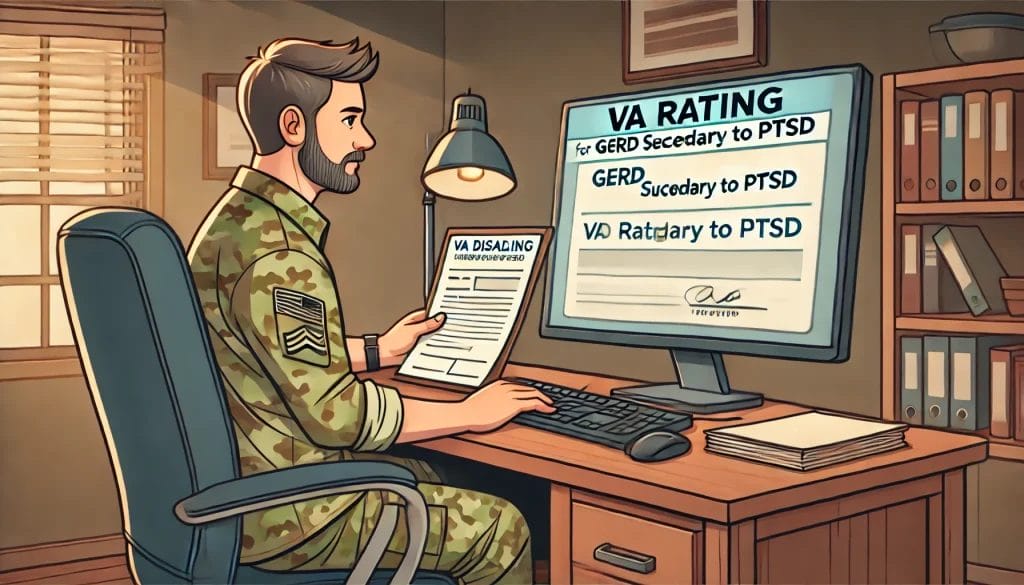Many veterans experience both Post-Traumatic Stress Disorder (PTSD) and Gastroesophageal Reflux Disease (GERD), two conditions that can be directly connected.
PTSD affects the body in various ways, including causing stress-related conditions like GERD. For veterans seeking VA disability compensation, understanding how to file a claim for GERD secondary to PTSD can help in securing the benefits they deserve.
Can PTSD Cause GERD?
Studies show that PTSD can have a significant impact on a veteran’s gastrointestinal system. Chronic stress, anxiety, and tension—common symptoms of PTSD—can lead to conditions like GERD. Veterans with PTSD may experience more frequent or severe episodes of GERD due to the body’s response to long-term stress.
GERD is caused by acid reflux, which occurs when stomach acid flows back into the esophagus, causing symptoms like heartburn, chest pain, and difficulty swallowing. Veterans with PTSD may develop GERD due to heightened cortisol levels and increased tension in the body, which can interfere with normal digestion.
For more on how stress and PTSD affect gastrointestinal health, read this study from NCBI: The Impact of PTSD on GI Disorders.
Need Some More Help with your VA Disability?
Learn more about the VA Disability process and get help with our VA Disability Chatbot programmed and trained by AI

GERD Secondary to PTSD: How to File a VA Claim
Veterans can file a secondary VA disability claim if their GERD is linked to their service-connected PTSD. Filing a secondary claim requires showing that your GERD developed or worsened because of your PTSD. Here’s how to file a claim for GERD secondary to PTSD:
- Service Connection for PTSD: First, ensure you have a service-connected disability for PTSD. This means the VA has already determined that your PTSD is related to your military service.
- Submit Medical Evidence: Gather medical records showing that you developed GERD after your PTSD diagnosis or that your GERD worsened due to PTSD. Medical records should document symptoms of GERD, such as heartburn, regurgitation, and difficulty swallowing.
- Get a Nexus Letter: A nexus letter from a healthcare provider is essential. This letter should explain how your PTSD likely caused or contributed to the development of GERD. A strong nexus letter can significantly improve your chances of getting a secondary service connection.
- File VA Form 21-526EZ: To officially file your claim, use VA Form 21-526EZ. This form can be submitted online, by mail, or through a Veterans Service Officer (VSO).
For more details on filing a claim for GERD secondary to PTSD, visit the VA’s Guide on Secondary Conditions.
VA Disability Rating for GERD Secondary to PTSD
The VA rating for GERD is based on the frequency and severity of symptoms, as well as the impact on a veteran’s daily life. GERD is rated under the VA’s Schedule of Ratings for the Digestive System, specifically under Diagnostic Code 7346 for hiatal hernia (as GERD does not have a unique diagnostic code).
Rating Percentages for GERD
- 10% Rating: Mild symptoms such as occasional heartburn, regurgitation, or mild discomfort that can be managed with medication.
- 30% Rating: More frequent episodes of GERD, with symptoms like recurrent epigastric distress, difficulty swallowing, and significant heartburn, causing considerable pain and discomfort.
- 60% Rating: Severe symptoms, including constant pain, significant weight loss, anemia, or frequent regurgitation with additional health complications.
For more specific examples of VA ratings for GERD, you can explore these cases on VA.gov:

GERD Secondary to PTSD Rating: How the VA Rates It
When filing a claim for GERD secondary to PTSD, the VA will look at the severity of your GERD symptoms and whether they were caused or worsened by your PTSD. In such cases, the VA will assign a separate rating for GERD based on the diagnostic criteria outlined above.
For example:
- A veteran with moderate GERD symptoms such as frequent heartburn and difficulty swallowing may receive a 30% rating for GERD.
- If GERD is severe, with symptoms like anemia, weight loss, and near-constant regurgitation, the veteran could receive a 60% rating.
It is important to note that the VA’s anti-pyramiding rule ensures that veterans are not compensated twice for the same symptoms. If both PTSD and GERD contribute to overlapping symptoms (such as stress-induced nausea), the VA will evaluate which condition primarily causes the disability.
Filing a Claim for GERD Secondary to PTSD
When filing for GERD secondary to PTSD, veterans need to provide as much medical evidence as possible to show the connection between the two conditions. Here’s a quick checklist of what you’ll need:
- Medical Records: These should include documentation of your PTSD diagnosis and how GERD developed or worsened after your PTSD diagnosis.
- Nexus Letter: A healthcare provider’s letter connecting your GERD to PTSD.
- VA Form 21-526EZ: Official form to submit your secondary disability claim.
- Compensation and Pension (C&P) Exam: The VA may schedule a C&P exam to assess the severity of your GERD symptoms and their relationship to your PTSD.
Visit the VA’s eBenefits portal to file your claim online: VA eBenefits.
For more information on secondary conditions and how to file, refer to this detailed resource: VA Disability for IBS Secondary to PTSD.
